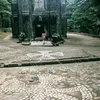Gingee fort – called by the British as the “Troy of the East” is a majestic fort located in the state of Tamil Nadu. We chanced upon it on our road trip from Bangalore to Pondicherry.

Setting off from Bangalore by 9:00 am, we reached the town of Thiruvannamalai in Tamil Nadu by 1:00 pm and it’s here that we started seeing the road signs pointing to the Gingee fort. There were also signs leading to the Sathanur dam, we had to make a choice – fort or dam; we chose the Gingee fort.
The kid was not happy; visit to the fort meant we would spent at least two hours exploring the place, else it would take only a hour more to reach Pondicherry; we had a late but light breakfast and the kid was looking forward to a scrumptious lunch in Pondicherry. Lunch was put on hold.
Half an hour later we were in Gingee, the tarmac cuts right across the fort area and we could see ruins perched upon massive hillocks on either side. Gingee, situated in north Tamil Nadu, built by the Nayakas and razed to ground by the Mughals; was a glorious and significant city right from the time of the Vijayanagara empire. Subsequently, the Marathas led by Chhatrapati Shivaji conquered it; they lost it to the Mughals and finally the British took over.
By 1:30 pm, after taking the tickets, we were inside the Gingee fort; afternoon sun was mercilessly hot; we trudged on.

Missing the crowds otherwise seen in touristy spots, inside were few families on picnic under the shade of massive banyan trees orbited by monkeys. There are lot of monkeys around.
The majestic Kalyana Mahal
It’s the first structure you see and if you are like me – have a thing for arches and stepped wells, you can forever keep taking pictures of this well preserved and beautiful building.

We are dependent on the description written on the plaques placed by ASI (Archaeological Survey of India) to make sense of this structure. Kalyana Mahal was inhabited solely by women. The stepped well is surrounded by rooms with arches. There are no doors seen. There is a raised platform at the centre of the well. Can we climb the tower of the Kalyana Mahal? There are no doors seen…but cleverly hidden along the wall is a narrow staircase. We make way to the top…

Even in ruins the building looks majestic – seven stories high, built without cranes; imagine it in it’s heydays – lamps lit along the small windows, curtains and decorations adorning the pillars.
Horse Stables or Royal staffrooms?
While climbing the tower of the Kalyana Mahal, the next structure that gets your attention is the neat row of enclosures with arches – the ASI plaque at the fort site calls them as horse stables, going onto say that the horses were important at the time and well looked after. But going to the ASI website tells a different story “the rows of enclosure for the royal staff (wrongly named horse stables)”.
What do you think? Will the stables be this close to the living quarters? The rooms are small, no doors again.

Father Pigment
The plaques set up by the Archaeological Survey of India (ASI) at the fort mention a Father Pigment, a Portuguese traveller who talks about an eleven storey building adjacent to the Kalyana Mahal, that had a throne room and a surrounding verandah on the ground floor; destroyed by the Mughals. Though the mention of a Portuguese Father Pigment is not seen anywhere else; it could possibly be the Portuguese Jesuit named Nicholas Pimenta.

Hard to imagine an eleven storied structure here, razed to the ground; debris? If there was, it must have been phenomenal; the seven storied Kalyana Mahal looks magical, imagine an eleven storied building.
Granary or Gymnasium?
There is another large structure named as the Gymnasium at the fort; the ASI website clarifies this to be another large Granary. The so called Gymnasium is not compartmentalised like the granary (first picture below); it’s just one huge hall and the arched roof is soo…high !!


Elephant Tank
Another stepped well filled with water at the Gingee fort. Can’t imagine elephants drinking from this tank (maybe called so because it’s a big tank !?). The pillars supporting the narrow enclosure around the tank are geometric and beautiful. The water appears dirty, but the emerald green colour stays with you.

And yes, we spent a lot of time exploring, by now it was 3:30 pm and much to our dismay we were late to begin our climb to the top of the Rajagiri hill. It’s an hour’s climb and takes another hour to descend and hence not allowed to to up after 3:00 pm; the fort closes by 5 pm. Ticketing closes by 4:30 pm. So the climb to Rajagiri hill and Krishnagiri hill are still pending for us. Also after two hours of walking around in the hot sun, we were tired too.

And hence if anyone is planning a visit to the Gingee fort…do the climb first and then explore the structures in the foothill. Also it would be advisable to visit during the cooler months, the heat can play spoilsport when there is so much to explore. Almost a day will be required to cover all the structures with a break in between. It would be a good idea to pack eatables, the surroundings are pretty much vacant of shops.
The visit to the fort was not planned, else we would have started earlier from Bangalore. Exhausted from the heat and hungry; disappointed that we could not make it atop the hillocks, we said good-bye to Gingee and set off for Pondicherry (58 km away) by 3:30 pm. This was our first fort in Tamil Nadu and a spectacular one !!
Till next post, take care !!
For more pictures, please click on www.milesandsmiles.net.in

